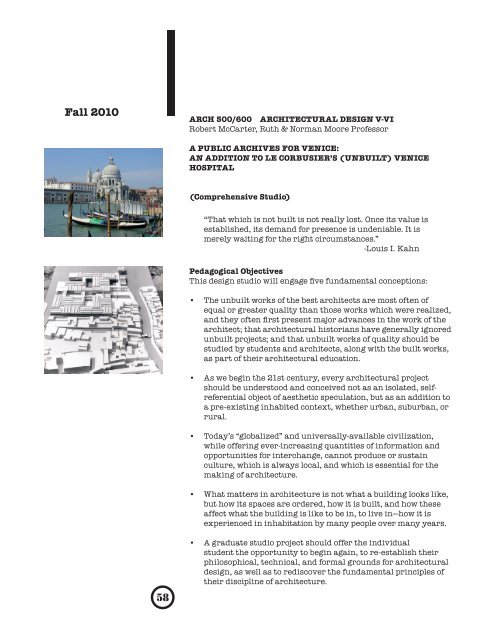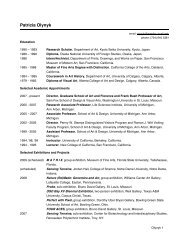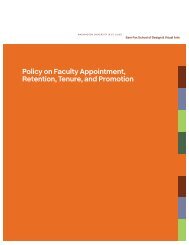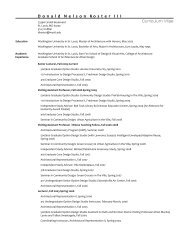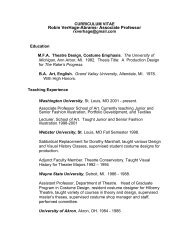architecture - Sam Fox School - Washington University in St. Louis
architecture - Sam Fox School - Washington University in St. Louis
architecture - Sam Fox School - Washington University in St. Louis
Create successful ePaper yourself
Turn your PDF publications into a flip-book with our unique Google optimized e-Paper software.
Fall 2010<br />
58<br />
ARCH 500/600 ARCHITECTURAL DESIGN V-VI<br />
Robert McCarter, Ruth & Norman Moore Professor<br />
A PUBLIC ARCHIVES FOR VENICE:<br />
AN ADDITION TO LE CORBUSIER’S (UNBUILT) VENICE<br />
HOSPITAL<br />
(Comprehensive <strong>St</strong>udio)<br />
“That which is not built is not really lost. Once its value is<br />
established, its demand for presence is undeniable. It is<br />
merely wait<strong>in</strong>g for the right circumstances.”<br />
-<strong>Louis</strong> I. Kahn<br />
Pedagogical Objectives<br />
This design studio will engage five fundamental conceptions:<br />
• The unbuilt works of the best architects are most often of<br />
equal or greater quality than those works which were realized,<br />
and they often first present major advances <strong>in</strong> the work of the<br />
architect; that architectural historians have generally ignored<br />
unbuilt projects; and that unbuilt works of quality should be<br />
studied by students and architects, along with the built works,<br />
as part of their architectural education.<br />
• As we beg<strong>in</strong> the 21st century, every architectural project<br />
should be understood and conceived not as an isolated, selfreferential<br />
object of aesthetic speculation, but as an addition to<br />
a pre-exist<strong>in</strong>g <strong>in</strong>habited context, whether urban, suburban, or<br />
rural.<br />
• Today’s “globalized” and universally-available civilization,<br />
while offer<strong>in</strong>g ever-<strong>in</strong>creas<strong>in</strong>g quantities of <strong>in</strong>formation and<br />
opportunities for <strong>in</strong>terchange, cannot produce or susta<strong>in</strong><br />
culture, which is always local, and which is essential for the<br />
mak<strong>in</strong>g of <strong>architecture</strong>.<br />
• What matters <strong>in</strong> <strong>architecture</strong> is not what a build<strong>in</strong>g looks like,<br />
but how its spaces are ordered, how it is built, and how these<br />
affect what the build<strong>in</strong>g is like to be <strong>in</strong>, to live <strong>in</strong>—how it is<br />
experienced <strong>in</strong> <strong>in</strong>habitation by many people over many years.<br />
• A graduate studio project should offer the <strong>in</strong>dividual<br />
student the opportunity to beg<strong>in</strong> aga<strong>in</strong>, to re-establish their<br />
philosophical, technical, and formal grounds for architectural<br />
design, as well as to rediscover the fundamental pr<strong>in</strong>ciples of<br />
their discipl<strong>in</strong>e of <strong>architecture</strong>.


